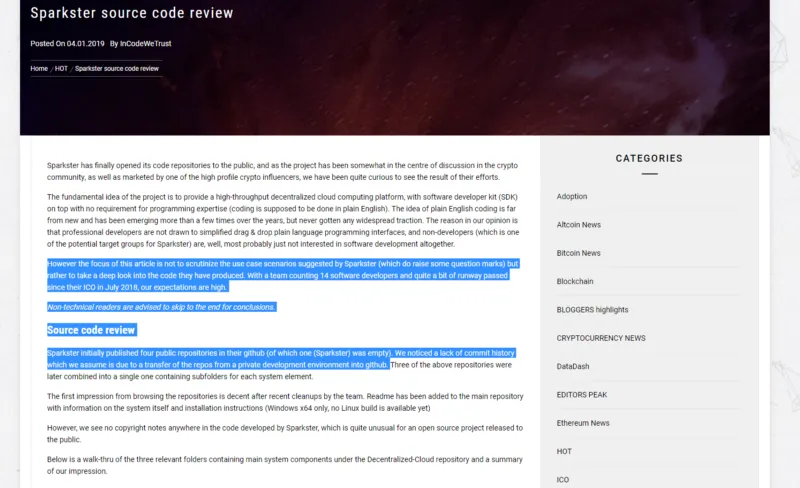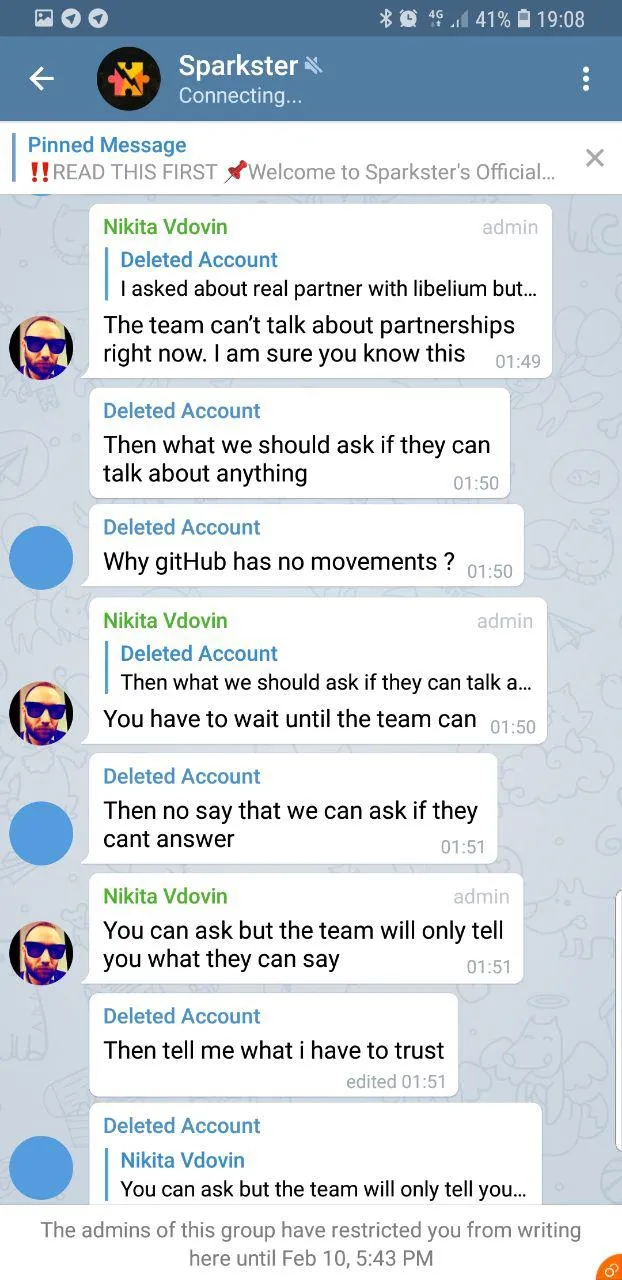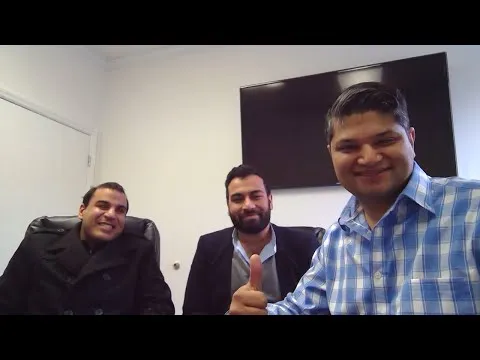The last time I spoke about Sparkster on this channel was in November last year where I exposed a leaked security report that had some concerning revelations. In the video, I brought up all of the flaws that I saw with the project, and there were many. Of course, I want you to watch that video to get the full picture but as a recap, a source shared with me a security audit for Sparkster’s platform, and it was found that there were several vulnerabilities that could have resulted in KYC data being accessed.
In an AMA with Sparkster’s CEO, Sajjad Daya released a few days later he claimed the report was part of their bug bounty programme and was a part of their security process. Saj claimed that they had checked their systems and that no one else had used the exploit. Yet the author of that report confirmed that everything I said in the video was absolutely correct and that there was no way to tell if someone had used the same exploit before he found it.
I pointed out that the project itself was highly flawed. Sparkster has a good idea at its core, making blockchain programming simple and accessible, but the execution of that idea has been a complete mess. The software looked basic and visually identical to MIT’s app inventor, and to add to that MIT’s app inventor is open source and the code is free for others to integrate into their own platforms. This lead to some speculating that Sparkster was not using original code but was, in fact, a rehashing of a free open source project.

Their CEO was desperately reaching out to established blockchain technology companies, offering them free integration into Sparkster, something he would normally charge a $2,000,000 set up fee and $100,000 a month subscription to do. Of course, he was flailing around trying to gain partnerships.

Sparkster raised an eye-watering $30,000,000 during its token sale. Instead of cashing out the $30,000,000, Saj left that money in Ethereum, and it became just $5,000,000 during the crash. He was even asked why he wasn’t selling. Eventually, he sold $900,000 worth of Ethereum after prices had dropped. Saj had made it clear that they needed to raise 30 million to fund this project so instead of exchanging to fiat to actually run the company and fund development he held it as some have suggested out of greed. The accusation is that Saj must have been speculating with the funds expecting the price to rise. This didn’t happen, and now Sparkster doesn’t have enough funds to complete their project or does it because this is where the confusion begins. Saj made it very clear that he needed every cent of the 30 million dollar target to make this project happen. Yet when asked about funding the project after the ICO closed he said; funding isn’t an issue, I am personally funding Sparkster and can sustain current levels for the foreseeable future. Well if that's true why did he need to raise $30,000,000 in the first place?



At this time tokens were still locked up and not on an exchange, Over the Counter trading was the only option available to investors, and the price of the Spark tokens dropped to just 5 cents each. Investors were getting agitated and rightly so.
I didn’t make the video a personal attack on the people at Sparkster or their CEO Sajjad Daya, in fact, to avoid it looking like it was something personal I made sure not to even name Saj in the video. My problem was with the project in its entirety and not with any individual. In his follow up AMA he then made a threat of legal action against me and leaning into the camera said he would hit me back 10 times as hard.
He, of course, hasn’t and I felt I had made my point so left the issue behind.
So I already made it clear I was no fan of Saj or Sparkster, and I felt I had made my point so why are we talking about them again now? Is it because I want the views and like to feed my Ego? Or is it because a large group of investors is considering a class action lawsuit? Are there grounds for legal action? Should Saj be worried? And what can he do to avoid litigation?
Since my video in November the only progress Sparkster seems to have made is in the number of people it’s banned from its Telegram group. This, however, has resulted in a growing number of investors calling for a class action lawsuit against Sparkster. The reasons are numerous, and if you are an investor in Sparkster, perhaps you have also found them to be a concern.
What this all comes down to is a mismanaged project with an inexperienced or demotivated team at its helm. The ICO ended in June last year and with 14 coders on the project, progress has been slow and the project has come under fire.
After backlash in November following my video… yes, I am taking credit for it: Sparkster released a copy of their code for investors to review. It’s almost a bit sad how excited and pleased with himself Saj looked when the code released only to receive huge amounts of criticism from the Sparkster community.
The code was reviewed by InCodeWeTrust, and the report was damaging. Unfortunately for them, it looks like releasing the code was a big mistake. The report which you can see here with me now states the focus of this article is not to scrutinize the use case scenarios suggested by Sparkster (which do raise some question marks), something I have said myself, but rather to take a deep look into the code they have produced. With a team counting 14 software developers and quite a bit of runway passed since their ICO in July 2018, our expectations are high.
https://cryptodiffer.com/news/sparkster-source-code-review/
It says that Non-technical readers are advised to skip to the end for conclusions. But I’m a Genius so we will go through all of it, maybe not all of it because that would be boring for everybody but we will go through the important things.

It says they published their initial public repositories to GitHub and some of the histories was missing but that was probably due to them transferring from a private development phase to GitHub… The concern, however, is that they haven’t updated Github since December from what I can see and that creates some worry.
They point out that there are no copyright notes in the code that they have produced at Sparkster which is quite unusual for an open source project released to the public. … of course this is unusual because if you are giving your code to the public it’s important that any conditions for its usage are set out for people. Often you would want at the very least a clause that ensures credit is given to the original development team when it is re-used. There is none of that information in the code there at all.
They say the source code is written in C++. Everything we see is very basic. In total there are is not a lot of unique code (we expected much more given the development time spent) and a lot of that a lot of the code is added on from other projects but they did have copyright notes for those parts.
Now, this is an important line: We cannot see anything in the code that differentiates the node and makes it special in any way, i.e. this is blockchain 101. What really worries me about this line here is that if they are saying this is Blockchain 101 they are saying that this is the most basic of blockchain code.
In the hands of a skilled developer, they can probably code a basic blockchain in a day or two. Probably even less if they have experience of doing this. Now I myself am taking a course at the moment learning how to develop blockchains and over the course of the training, I will learn how to code a basic blockchain in a few hours an evening over a couple of weeks. That is incredibly concerning when you take into consideration that the company has $30,000,000, 14 developers on the team apparently and yet InCodeWeTrust describe this as Blockchain 101.
Here we can see that for storage they are using IPFS, I have mentioned IPFS in a previous video it is a decentralized storage blockchain project which is also somebody else's open source project.

I made this point that the software looks a lot like MIT’s app inventor program. Which is also an open source program you can take and use as you like. This report doesn’t state the code is copied, but if we go back up and look here, they state that a lot of their code is missing copyright information. You wouldn’t copyright code that doesn’t belong to you, would you? I’ve already mentioned before that there were claims that Sparkster is allegedly built using the MIT source code or parts of it. The whole project sounds like they’ve taken bits and pieces from other peoples projects and have put it together while claiming it’s breaking the mould.
The conclusion itself is very damaging, it says here:
In total Sparkster has produced a limited amount of very basic code, with a team of 14 developers at their disposal. As their announcement suggests that this is the complete code for their cloud platform main net, we must assume that the productivity of the team has been quite low over the months since funds were raised, since none of the envisioned features for high performance are yet implemented.
The current repository is not on par with standards for a mainnet release and raises some serious question marks about the intention of the project altogether. The impression is that the team has taken a very basic approach and attempted to use shortcuts in order to keep their timelines towards the community, rather than develop something that is actually unique and useful. This is further emphasized by the fact that the Sparkster website and blockchain explorer is built on stock templates. We don’t see any sign of advanced development capability this far. I can quickly show you the $49 template that explorer is built off of here.
Based on what we see in this release Sparkster is currently not a platform for ”full-scale support to build AI-powered apps” as their roadmap suggest and we are puzzled by the progress and lack of provisioning of any type of SDK plugin. The Sparkster team has a lot to work on to even be close to their claims and outlined roadmap.

Saj asks the community to trust them but how can the community trust you, when you have had 30,000,000 dollars in funding, months and months of development time, 14 developers which is something like 10,000 man-hours and over those hours you have provided the most basic of code. Without even looking at the code and going by the conclusion of the report I would say this could have been written by 1 or 2 developers over the course of a week or two.
Sparkster responded to the report as you can see here but the important thing to note is that despite their objections and their comments about what they are going to implement the team at InCodeWeTrust wrote the following: we have been in contact with the Sparkster team prior to publishing this review, in order to provide opportunity for them to comment on our observations. Their answers are listed below but, don't change our overall conclusions of the current state of Sparkster development.
We keep hearing excited claims from Saj and his team about upcoming partnerships but he can’t tell us about any of them because they are under NDA but then his colleague Shabir says in the latest AMA that he is working on getting strategic inroads with companies and executives within those companies to make solid relationships. Within the first 6 minutes of the same video, Saj himself says the NDA’s are in place so they can have these discussions with the companies. Building those relationships is great and it’s very important but that isn’t a partnership.
Of course, if an NDA applies that makes sense that the partnership can’t be announced, but Sparkster has essentially lost the trust of their investors, so this news is rightfully met with scepticism.
Some investors and members of the Sparkster community have begun to confront Saj, his team and the admins on Telegram and social media. He has stated that some of that criticism has been very hostile and threatening. If that’s true, we should all do our best to refrain from threats against admins and staff, but it is clearly borne out of frustration. The terms of the token sale were very clear; there was going to be no token lockup on completion of the ICO except for bonuses held by the early investors. The tokens are still locked up several months later. Sparkster was going to hold a community vote in December to decide on whether the lockup should be lifted. The vote was cancelled.

By the end of the AMA video, Saj gives his investors a lengthy lecture about sticking together or missing out. That they will succeed with or without the community behind them, they are working full time on the project, and are committed to seeing the company succeed. The following day they started mass banning investors from their Telegram group and deleting negative messages and even tough questions from the channel.
I was contacted yesterday from a substantial group of Sparkster investors who are discussing a potential class-action lawsuit against Sparkster. This action, of course, would result in the destruction of Sparkster itself. Their own investments would be destroyed in the process, it would be the nuclear option.
Investors in Sparkster are in a very tough spot right now. Their investments are fully locked up and there has been a lot of bad press for Sparkster over the course of the last year. To most investors, this looks like a case of severe mismanagement. I will say this in Sajjid Daya’s defense though. He may be completely correct about the consequences of unlocking the tokens right now. With the report out there stating that the code is substandard, the mismanagement of funding and the lack of a clear roadmap and direction at this point could mean doom for the token price. The dilemma that investors’ face, do they force Saj’s hand to unlock tokens now and potentially lose all of their investment or do they ignore the failed promises so far and trust him and his team to deliver eventually, whenever eventually maybe?
Sparkster’s CEO Saj Daya may not have many options himself to deal with the growing dissent among the community. He can, of course, ignore it, ban it, or threaten it. He could release the tokens and watch the price collapse or he could take the Ethereum he still holds and reimburse the investors with what he has. None of these options is a great choice. One thing he could do is make moves to regain the communities trust. To create a level of accountability and transparency the community could vote on a board of non-executive officers. Independent from Sparkster’s directors they would be involved in developing the policies and planning of the company and would monitor the companies directors acting in the interest of the token holders. This won’t solve Sparkster’s problems overnight but investors would then at least know that someone independent is ensuring the company is working to their best interests. To be honest I’m surprised more Blockchain companies and investors haven’t been looking at this as a way of building trust with their communities.
In closing, I can only say that I hope whatever happens next in Sparkster’s story is positive and that they really can up their game and make these partnerships materialize, not for Sajjid Daya’s sake but for the investors who have found themselves in an impossible situation.
What do you guys think?
Is there still hope for Sparkster? Is their CEO right? Which of the solutions would you accept? And would you join a class action lawsuit at this stage or do you think this is just hurting the project even more? If so let us know in the comments below. We really like to hear your thoughts on the stories we run so, please get involved.
To keep up with the latest crypto news like, subscribe and don’t forget to hit that notification bell.
Please join us at our Telegram Group and follow us.
Disclaimer: Cryptopig content is written by a team of blockchain passionate people. We are not registered as investment advisors. Don’t take the information in this post as investment advice and make sure you do your own research before investing. Cryptocurrencies are a very risky investment, never invest more money than you can afford to lose.



